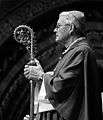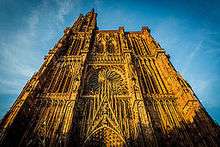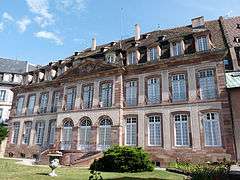Roman Catholic Archdiocese of Strasbourg
| Archdiocese of Strasbourg Archidioecesis Argentoratensis o Argentinensis Archidiocèse de Strasbourg | |
|---|---|
|
| |
| Location | |
| Country | France |
| Metropolitan | Immediately subject to the Holy See |
| Statistics | |
| Area | 8,280 km2 (3,200 sq mi) |
| Population - Total - Catholics |
(as of 2010) 1,900,000 1,360,000 (71.6%) |
| Information | |
| Denomination | Roman Catholic |
| Rite | Roman Rite |
| Established |
4th century (Diocese) 1 June 1988 (Archdiocese) |
| Cathedral | Cathedral of Notre Dame in Strasbourg |
| Patron saint | Saint Arbogast |
| Current leadership | |
| Pope | Francis |
| Archbishop | Jean-Pierre Grallet |
| Auxiliary Bishops |
Vincent Dollmann Christian George Nicolas Kratz |
| Emeritus Bishops | Joseph Doré Archbishop Emeritus (1997-2007) |
| Website | |
| Official website | |
| Part of the series on |
| Alsace |
|---|
.svg.png) Rot un Wiss, flag of Alsace since 11th century. |
|
(including Lorraine) |
|
|
Alsace in the EU |
|
Related topics |
|
The Roman Catholic Archdiocese of Strasbourg (Latin: Archidioecesis Argentoratensis o Argentinensis; French: Archidiocèse de Strasbourg; German: Erzbistum Straßburg) is an archdiocese in Strasbourg, Alsace, France, of the Latin Rite of the Roman Catholic Church in France, first mentioned in 343. The archdiocese, with seat in the Cathedral of Notre Dame in Strasbourg as mother church, is unique in France as it has no suffragans and is an immediately subject to the Holy See in Rome. It is currently headed by Archbishop Jean-Pierre Grallet, in office since April 2007.
The Diocese of Strasbourg was first mentioned in 343, belonging to the ecclesiastical province of the Archbishopric of Mainz since Carolingian times. Archeological diggings below the current Église Saint-Étienne in 1948 and 1956 have unearthed the apse of a church dating back to the late 4th or early 5th century, considered the oldest church in Alsace. It is supposed that this was the first seat of the Diocese.[1] Since the 15th century, the diocesan seat has been the cathedral of Notre-Dame de Strasbourg. The bishop was the ruler of an ecclesiastical principality (prince-bishopric) in the Holy Roman Empire during the Middle Ages and Early Modern period. For this state, see Prince-Bishopric of Strasbourg. By the Concordat of 1801 the Strasbourg diocese became a public-law corporation of cult (French: établissement public du culte) and the diocesan ambit of Strasbourg was redrawn and all its areas east of the river Rhine were redeployed, forming a part of the Archdiocese of Freiburg since 1821. In 1871 the bulk of the diocese became part of German Empire, while small fringes remained with France. In 1874 Strasbourg diocese, with its diocesan ambit reconfined to the borders of then German Alsace, became an exempt diocese immediately subject to the Holy See. When the 1905 French law on the Separation of the Churches and the State was enacted, doing away with public-law religious corporations, this did not apply to the Strasbourg diocese then being within Germany.
After World War I Alsace along with the diocese was returned to France, but the concordatary status has been preserved since as part of the Local law in Alsace-Moselle. Although not as metropolitan of an ecclesiastical province, the diocese was elevated to an archdiocese on 1 June 1988 by Pope John Paul II. The bishop of this see is appointed by the French president according to the Concordat of 1801. The concordat further provides for the clergy being paid by the government and Roman Catholic pupils in public schools can receive religious instruction according to archdiocesan guide lines.
As of 31 December 2003, the area of the archdiocese comprised a total of 1,713,416 inhabitants of which 75.9% (1,300,000) are Catholics, divided in 762 parishes covering an area of 8,280 km². Also, 619 diocese priests, 50 deacons, 288 ordained priests and 1,728 nuns belong to the archdiocese.
Ordinaries
- Leopold Erzherzog von Österreich † (24 November 1607 Succeeded - 19 April 1626 Resigned)
- Leopold Wilhelm Erzherzog von Österreich † (10 October 1626 Appointed - 2 November 1662 Died)
- Franz Egon Fürst von Fürstenberg † (19 January 1663 Appointed - 1 April 1682 Died)
- Wilhelm Egon Fürst von Fürstenberg † (8 June 1682 Appointed - 10 April 1704 Died)
- Armand-Gaston-Maximilien de Rohan de Soubise † (10 April 1704 Succeeded - 19 July 1749 Died)
- François-Armand-Auguste de Rohan-Soubise-Ventadour † (19 July 1749 Succeeded - 28 June 1756 Died)
- Louis César Constantin, prince de Rohan-Guéméné † (23 September 1756 Appointed - 11 March 1779 Died)
- Louis René Édouard de Rohan-Guéméné † (11 March 1779 Succeeded - 29 November 1801 Resigned)
- Jean-Pierre Saurine † (9 April 1802 Appointed - 7 May 1813 Died)
- Gustave-Maximilien-Juste de Croÿ-Solre † (8 August 1817 Appointed - 4 July 1823 Appointed, Archbishop of Rouen)
- Claude-Marie-Paul Tharin † (23 August 1823 Appointed - 16 November 1826 Resigned)
- Jean-François-Marie Le Pappe de Trévern † (13 December 1826 Appointed - 27 August 1842 Died)
- Andreas (André) Räß (Raess) † (27 August 1842 Succeeded - 17 November 1887 Died)
- Pierre-Paul Stumpf † (17 November 1887 Succeeded - 10 August 1890 Died)
- Adolf Fritzen (Fitzen) † (24 January 1891 Appointed - 31 July 1919 Retired)
- Charles-Joseph-Eugène Ruch † (23 April 1919 Appointed - 29 August 1945 Died)
- Jean-Julien Weber, P.S.S. † (29 August 1945 Succeeded - 30 December 1966 Retired)
- Léon-Arthur-Auguste Elchinger † (30 December 1966 Succeeded - 16 July 1984 Retired)
- Charles Amarin Brand † (16 July 1984 Appointed - 23 October 1997 Retired)
- Joseph Pierre Aimé Marie Doré, P.S.S. (23 October 1997 Appointed - 25 August 2006 Resigned)
- Jean-Pierre Grallet,O.F.M. (21 April 2007 Appointed - present)
Gallery
 Current (2015) archbishop Jean-Pierre Grallet
Current (2015) archbishop Jean-Pierre Grallet Grand portal of Episcopal Palace, Strasbourg
Grand portal of Episcopal Palace, Strasbourg- Secondary building of Episcopal Palace

See also
References
External links
| Wikimedia Commons has media related to Roman Catholic Archdiocese of Strasbourg. |
- Official website of the diocese
- Official website of the cathedral
- Archbishopric of Strasbourg at Catholic-Hierarchy.org
- Image of the cathedral
-
 Herbermann, Charles, ed. (1913). "Strasburg". Catholic Encyclopedia. New York: Robert Appleton Company.
Herbermann, Charles, ed. (1913). "Strasburg". Catholic Encyclopedia. New York: Robert Appleton Company.
Coordinates: 48°34′53″N 7°45′06″E / 48.5813°N 7.75162°E
